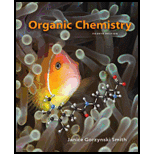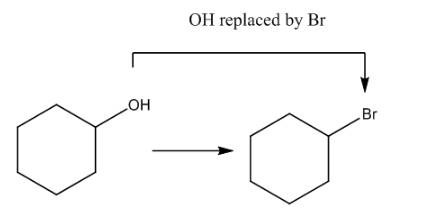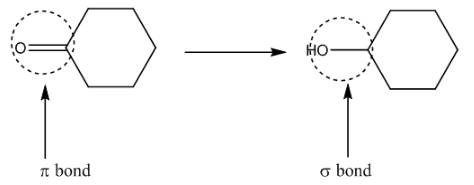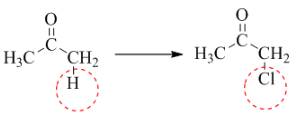
Concept explainers
(a)
Interpretation: The given transformation is to be classified as substitution, elimination, or addition reaction.
Concept introduction: The substitution reactions involve the substitution or replacement of an atom or group of atoms in a compound by another atom or groups of atoms. In the substitution reactions, the replacement takes place by the break down of sigma bonds.
In elimination reaction, the formation of
Answer to Problem 6.1P
The given transformation is an example of a substitution reaction.
Explanation of Solution
The given transformation is shown as,

Figure 1
In the above reaction, the hydroxyl group is replaced by a bromine atom. The breakdown of the sigma bond precedes the mechanism. On replacement of the hydroxyl group, one sigma bond breaks and another is formed at the same position. Therefore, it is classified as the substitution reaction.
The given transformation is classified as a substitution reaction.
(b)
Interpretation: The given transformation is to be classified as substitution, elimination, or addition reaction.
Concept introduction: The substitution reactions involve the substitution or replacement of an atom or group of atoms in a compound by another atom or groups of atoms. In the substitution reactions, the replacement takes place by the break down of sigma bonds.
In elimination reaction, the formation of
Answer to Problem 6.1P
The given transformation is an example of an addition reaction.
Explanation of Solution
The given transformation is shown as,

Figure 2
The above reaction involves the breakdown of
The given transformation is classified as an addition reaction.
(c)
Interpretation: The given transformation is to be classified as substitution, elimination, or addition.
Concept introduction: The substitution reactions involve the substitution or replacement of an atom or group of atoms in a compound by another atom or groups of atoms. In the substitution reactions, the replacement takes place by the break down of sigma bonds.
In elimination reaction, the formation of
Answer to Problem 6.1P
The given transformation is an example of a substitution reaction.
Explanation of Solution
The given transformation is shown as,

Figure 3
In the above reaction, the hydrogen is replaced by chlorine. The breakdown of the sigma bond precedes the mechanism. On the replacement of hydrogen, one sigma bond breaks and another sigma bond is formed between carbon and substituent atom.
The given transformation is classified as a substitution reaction.
(d)
Interpretation: The given transformation as substitution, elimination, or addition is to be classified.
Concept introduction: The substitution reactions involve the substitution or replacement of an atom or group of atoms in a compound by another atom or groups of atoms. In the substitution reactions, the replacement takes place by the break down of sigma bonds.
In elimination reaction, the formation of
Answer to Problem 6.1P
The given transformation is an example of an elimination reaction.
Explanation of Solution
The given transformation is shown as,

Figure 4
In this reaction, the formation of
The given transformation is classified as an elimination reaction.
Want to see more full solutions like this?
Chapter 6 Solutions
Organic Chemistry
- "Nucleophilic substitution reaction"" When does the bond between the leaving group and C break? Does it break at the same time that the new bond between the nucleophile and C forms? Or Does the bond to the leaving group break first.arrow_forwardConsider the synthesis scheme in Figure 12. Draw the structure of B.arrow_forwardDevise a synthesis of each attached compound from cyclopentane and any other required organic or inorganic reagents.arrow_forward
- (a) Draw a stepwise mechanism for the conversion of A to B. (b) What product would be formed if C was exposed to similar reaction conditions?arrow_forwardDraw a stepwise mechanism for the attached reaction that forms ether D. D can be converted to the antidepressant fluoxetine (trade name Prozac) in a single steparrow_forwardWhich compound? a or b and whyarrow_forward
 Organic Chemistry: A Guided InquiryChemistryISBN:9780618974122Author:Andrei StraumanisPublisher:Cengage Learning
Organic Chemistry: A Guided InquiryChemistryISBN:9780618974122Author:Andrei StraumanisPublisher:Cengage Learning
